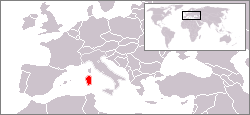Sardinian dhole
| Sardinian dhole Temporal range: Pleistocene–0.009 |
|
|---|---|
| Scientific classification | |
| Kingdom: | Animalia |
| Phylum: | Chordata |
| Class: | Mammalia |
| Order: | Carnivora |
| Family: | Canidae |
| Subfamily: | Caninae |
| Genus: | Cynotherium |
| Species: | C. sardous |
| Binomial name | |
|
Cynotherium sardous Studiati, 1857 |
|
 |
|
| Former range (in red) | |
The Sardinian dhole (Cynotherium sardous), also known as the Sardinian fox, was an endemic insular canid, that occurred on the Mediterranean islands of Sardinia (Italy) and Corsica (France). Its range was because both Sardinia and Corsica were joined for much of the Pleistocene. It became extinct when humans began to settle on the island. Its scientific name means "dog-beast of Sardinia".
When the ancestor of this canid, a species of the wolf-sized Xenocyon, became confined to the island, its diet became limited to small and fast prey, such as rodents and rabbits. This lack of large prey caused the Sardinian dhole to evolve into a small sized (perhaps 10 kg) canid. This view of Cynotherium as a predator specializing in small, fast prey is supported by an examination of the animal's anatomy. The evolution of short, powerful limbs, a low neck carriage and increased head and neck mobility suggests an animal well suited for stalking and then quickly pouncing on or running down small prey.
Despite its common name, Cynotherium sardous is not always listed as a relative of the modern dhole. Recent studies consider the Sardinian dhole a part of the tribe Canini and a relative of the genus Lycaon, which includes the African wild dog and the extinct Lycaon sekowei. As mentioned earlier, some species of Xenocyon thought to be the ancestor of Cynotherium. Another hypothesis posits that the Sardinian dhole is derived from a late population of Canis arnensis (or Canis mosbachensis).
...
Wikipedia
